The first truly radical example of that magnificent fifth of compact sports cars was the Focus RS. When the groundbreaking Focus hit the market, it was a huge leap forward from the Escort it replaced. Where the last Escort was a competent but logical car and not at all outstanding in driving dynamics, the Focus was a machine that even in its basic versions was capable of making you smile. It was the first Ford that changed the brand's genetics forever, with a multi-link rear suspension that gave it agility and precise handling, and positive, informative steering.
So great was the formula that we all started salivating at the thought of a sporty "RS Cosworth" variant to succeed the legendary Sierra and Escort legacy of huge spoilers. The problem was that since 1996, the last time Ford had built the Escort with Group A rally homologation in mind, the company hadn't shown any interest in creating such a monster, given the lack of market interest in performance compacts.
The story
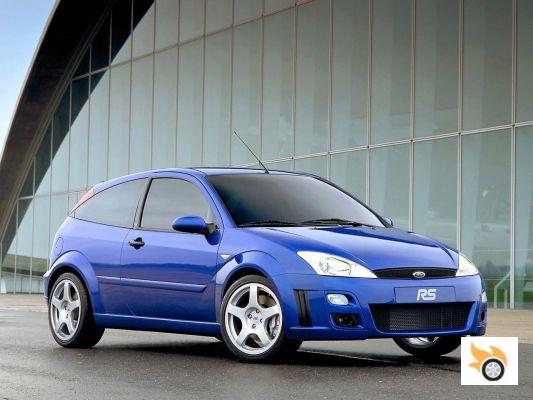
It took Ford more than two years to launch the Focus RS from the time it was first announced, creating a huge buzz.
In 1999 Ford broke into world rallying with the new Focus WRC, with Colin McRae at the wheel, a year after Carlos Sainz's departure from the team. The car made a huge impact for many reasons at the same time.
Firstly, because Colin McRae was a spectacle in his own right, adored in the UK. Secondly, because the car was so fast from the very first race. Everything was lining up for Ford to get the RS acronym back once and for all and plant it on the boot lid of the Focus.
To warm up, in that same 1999 Ford showed a concept under the name of Ford Focus Cosworth at the Los Angeles Motor Show, with 200 horsepower. The same prototype would be shown again with another color and 220 horsepower in January 2000, at the Detroit Motor Show.
But the "Cosworth" name's days were numbered. In world rallying M-Sport had begun to make its own engines without the help of the British manufacturer. Ford was beginning to move to divest itself of Cosworth (which would eventually be sold in 2004), so associating the model name with the engineering firm seemed unwise.
So for the Birmingham Motor Show at the end of 2000, Ford finally unveiled a tentative preview of the road car it was going to launch, under the name Focus RS. At that time it was confirmed aspects that until then were not known for sure: 200 were going to be the horses that the car would have, and it would be exclusively front-wheel drive. At that time it was not clear that Quaife was going to put a self-locking on the front axle, but at that time to think of 200 horses to be distributed only on the front wheels seemed complicated.
The birth of the Focus RS from that moment on was complicated. The car was planned to be in the dealerships as a limited edition in the spring of 2001, but the reality is that until the end of 2002 when the first units would be delivered in drips and drabs, being 2003 the year of the real arrival of the car to the market. It did so without the restyling raised in 2001 for the Focus, which makes it clear that Ford had had a particularly hard development with the car.
A great base and technical solutions
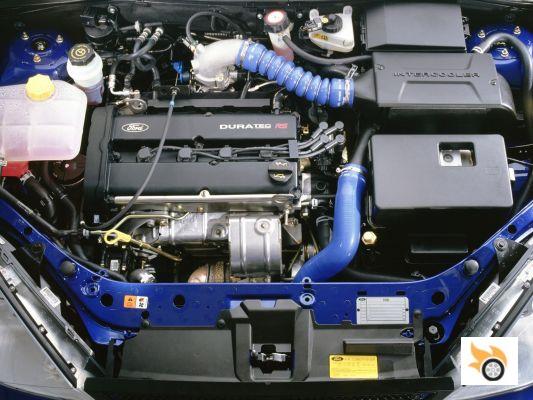
The engine was based on a veteran Zeta base, but featured forged pistons and connecting rods, and a state-of-the-art supercharger system.
The base of the Focus was already good in itself, but Ford wanted to go beyond a mere strengthening and stiffening of springs. For the blue oval firm, making an RS is a completely different path than making an ST, so instead of recalibrating what it already had, it came up with a car developed in many respects from scratch.
With Ford deep into the introduction of its Duratec engines (actually Mazda MZR engines), the Focus RS engine was officially called the Duratec RS, as it read on the rocker cover. But it wasn't. The engine was a Zetec-R, part of the "Zeta" MVH family with a cast iron block and aluminium cylinder head.
It may not be very technical in terms of materials, but the real key to this twin-cam, direct injection, 16-valve-per-cylinder engine was the supercharger system. The turbocharger was a Garrett specifically created for the car, codenamed GT2560LS. Like its relative used in the Nissan 200SX (in the SR20DET engine), the turbine was made from Inconel, an extremely heat-resistant alloy (in fact, it is used in aviation jet turbines). In addition, the Focus RS turbo featured a stainless, chromium-nickel steel housing, the first application of this material in a gasoline production car.
With bearings to reduce friction and an already compressed gas recirculation system, this Garrett turbo also showed the benefit of having less "lag", less inertia, at small changes in throttle load (that moment when you hollow the throttle for a moment so that the nose closes the corner and you return to it).
To withstand the turbo's over-pressure, the Zetec-R gained forged connecting rods and pistons and cooled its exhaust valve stems with sodium. The end result of all this was 215 maximum horsepower at 5,500 revs, with 310 Nm of peak torque available from 3,500 revs, a genuinely high figure for the time, and still remarkable 12 years later for a two-litre engine.
It was therefore a very rally engine, with more torque than power. Incidentally, instead of a conventional intercooler system, to save space and improve the distribution of mechanical parts, the intake air, after being compressed, was cooled by a liquid circuit, which in turn had a separate radiator. In this way it was possible to dispense with an intercooler on the engine "WRX STI style", or too long ducts that would negatively affect the "lag", or response time. The throttle body of this Focus works with a cable, instead of a digital system, being one of the last cars on the market to use this type of "analog" mechanism, which speaks of advantages in the way it responds to "old school" right pedal movements, but is also the reason why no traction or stability control could be integrated, tolls for using an old school Zetec engine.
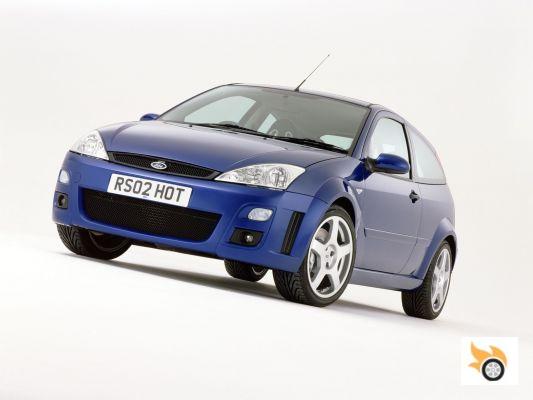
The Quaife worm-gear self-locking differential was the icing on the technical cake.
To pass the torque generated by this engine to the wheels, the first step was taken by an AP Racing clutch with composite material similar to that used in rally engines. From there it was multiplied in a gearbox with only five ratios. A six-speed gearbox was not chosen because at the time there was none that could withstand the 310 Nm of maximum torque and fit in the Focus's body.
The car's second mechanical surprise was housed inside the gearbox housing itself: a self-locking differential with helical gears designed by British specialist Quaife. Working much like a Torsen (but without violating any patents), Quaife's helical gear differentials offer the same advantages of any worm gear system: a continuously variable transfer of torque between the wheels of the same axle in inverse proportion to the speed of the wheels. So, if you start to lose torque on one wheel, the differential sends the available torque to the outside wheel in a ratio similar to the speed difference of those wheels.
The only two known problems with these gear differentials is that, on the one hand, if one wheel loses traction completely (it stays in the air), they are no longer able to send torque to the other wheel, which limits their use in competition. On the other hand, their very principle of operation makes them somewhat less efficient in power consumption than a traditional ramp differential.
But the fact that they work in a proportional and variable way instead of "sticking in all at once" like a disc differential, perfectly addressed the problem Ford had on its hands: to create a car that, having front-wheel drive and self-locking, would not be too rough and complicated to drive. In addition, a differential of this type does not require maintenance on its clutch discs, as it does not have them, something that does happen in the ramp differentials.
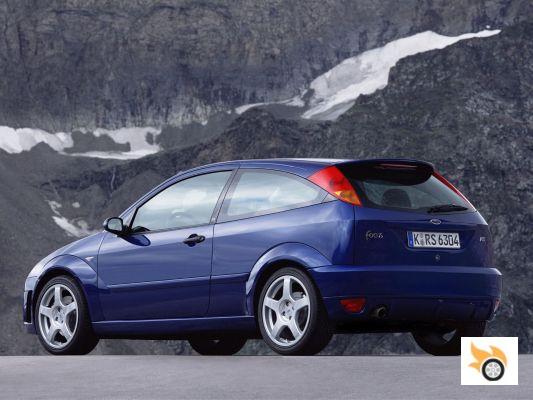
As for the running gear, the tracks were increased by 20 millimetres on the front axle and 27 on the rear axle compared to a normal Focus, which required new and wider wings. The springs were made shorter, the dampers more controlling and drier, the silentblocks stiffer, and the suspension geometries were completely revised (more on this below).
Braking power was provided by 325-millimeter Brembo discs bitten by slick four-piston rigid calipers, hidden behind 18-inch wheels, shod with Pilot Sport tires baked especially for this Focus RS.
Aerodynamically we could not say that the Focus RS was a drop of water, with a Cx of 0.37, but bumpers and rear spoiler were modified to improve the work with the surrounding air, both at the level of aerodynamic support of the rear axle, and at the level of feeding fresh air to the engine compartment.
At just 1,280 kilos, the power-to-weight ratio (5.9 kilos per horsepower) is still attractive in a world where we've become accustomed to seeing compact cars tinker around the one and a half ton mark. Of course, the absence of stability and traction controls in the Focus RS also takes us back to another era where knowing how to drive counted more than it does now...
Get in and sit back
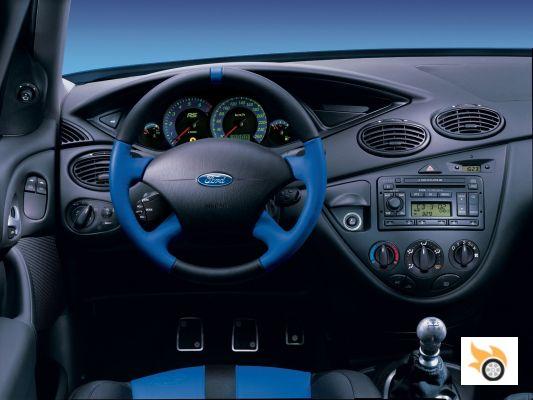
Admittedly, the judgment of time has treated the exterior of the Focus RS better than it has the interior. Being a car that was "generalist and correct" in its day, sitting down today we're struck by how demands have changed in the C-segment. Hard plastics and curved design are quite outdated.
What is not outdated are the excellent Sparco seats fitted for the occasion. It's clear that the Recaro CS of the Focus RS MK2 are a thousand times more supportive, but these Sparco ones are more than adequate. The instrument panel is striking for changing the coolant temperature needle in the main dome for a turbo pressure indicator that is absolutely useless.
The bottom of the dials are blue, like the car, and there's a nice little light to remind you to change gear. The gear knob is genuine aluminium (icy in winter, and don't try touching it if you've left the car in the sun while swimming on the beach...), and the engine is started by a cute little button, in a trend that in a way we could say was pioneered by the Focus RS and followed by many others after it.
Forget infotainment, as there's an average radio. The metal pedals remind you that this car is made for driving. The rear seats are decent in terms of side and headroom (not enough legroom, like in the 147 GTA), and the boot, at 350 litres, can still be considered adequate in size.
Turn the key, ignition position, press the start button and you get a 2.0 turbo engine sonatina of those rally car, nice and "racing".
On the move and on the attack

In the first few kilometres you discover that the Focus RS is a special car. The suspension is stiff, the damping is dry, the gearbox is short and precise, and the brake pedal is relatively hard, as is the clutch pedal.
The engine torque is present from two thousand turns, but has a clear effect "kick" from three thousand, so it is not as fine down as some of his contemporaries rivals who had greater displacement.
In the city the consumption can go up to 12 liters per 100 kilometers, but it is still less than the V6 Golf R32 or 147 GTA.
In street driving it hardly differs from the normal Focus in terms of versatility: it is a car where you can see where you are going and it is easy to place and park it, besides having, as I said above, a more than decent trunk.
If you go out on the open road for a long trip, things start to get a bit more complicated. For starters, it is a much noisier car than the others, with aerodynamic hum and an engine that lacks a sixth gear to turn more relaxed. Here we can make averages of nine liters or less (petrol 98 mandatory). The downside is in the suspension, which seems too hard if the road is not well paved and our back is delicate. The thin Sparco, with little padding, remind me here of the Sabelt that we have just mounted on the Abarth, being hard and transmitting a lot.
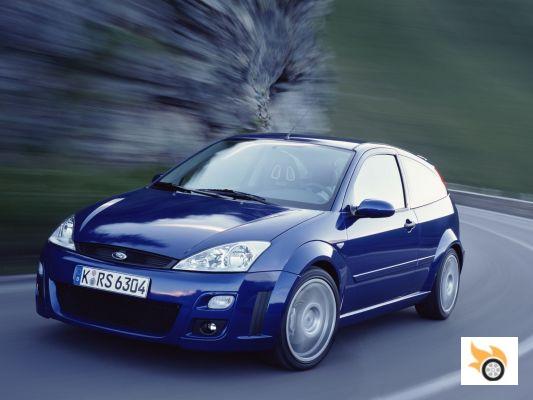
When driving on the attack, it's like driving a Group N rally car, with a hard but not bouncy damping and a differential that dominates the situation.
But the Focus RS's natural habitat is on the mountain road, in the rally section, where it blows you away. 215 horsepower may not seem like much, but the way the Focus RS moves is such that you can't help but fall in love with it.
In a straight line, you're engaging gears one after the other, focusing on the upcoming braking, and enjoying the gearbox. When it's time to brake, the pedals give you a textbook toe-tap. The middle one is especially commendable, as it allows you to precisely manage and administer the power you apply to the Brembo's before triggering the ABS.
You put the steering wheel in, quite directly, and the car pulls to the inside of the corner without hesitation. The time between putting the wheel in and getting firm support is almost imperceptible, which shows you why you've got stiff suspension.
The best of all is that, despite being a car with a hard setting, the dampers are very successful, and even with broken and curly asphalt, they are able to control the spring perfectly, without the wheels bouncing, so you don't have those bounces and escapes from behind that other more modern cars show off in a vain attempt to mount harder springs than the damping supports (MINI Cooper S, Abarth 500 with standard suspension...).
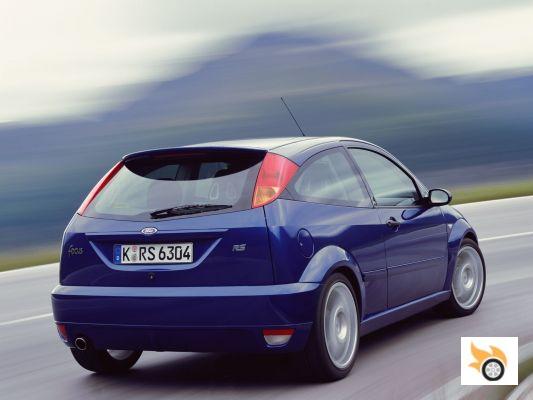
With the car leaning, in that waiting time while you go to the apex with some gas on the throttle, if you need to play with the rear, it's ready to play along with you. If you suddenly ease off the throttle, the car will yaw into the corner without a moment's hesitation. You can even play with braking with your left foot to do this (don't do it on the open road if you don't have it fully in hand on a circuit or closed section).
At the point when you start to accelerate, the right foot can drop almost all the way down at once, despite the fact that there are 310 Nm to manage and no traction control. Thanks to the exemplary work of the Quaife self-locking differential, the car follows the line you tell it to follow with the steering wheel, and even, if you give it more gas, it can yaw a bit more. That's why I'm in love with self-locking differentials in front-wheel-drive cars...
Of course, you have to have hands: the steering wheel is a bit of a handful, and will try to get out of your hands while you give full throttle, even on a straight line if the asphalt is not quite right or is a bit wet, so it's one of those cars to drive with both hands holding the steering wheel well so it doesn't get out of your hands.
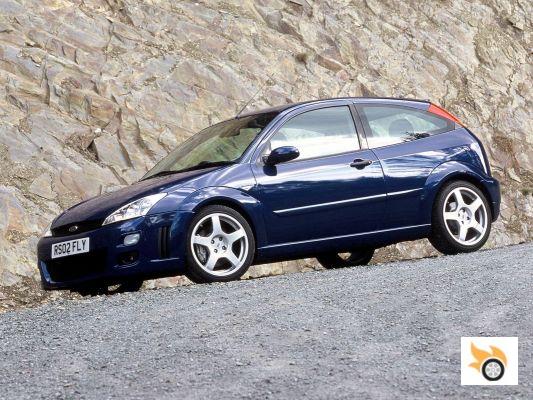
At 5,500 turns the logical thing to do is to shift up a gear, as you'll catch the engine in its good torque zone and you'll be able to keep going strong. But if you want to stretch the gear more because you have to brake very soon, the engine doesn't hesitate to keep revving up to 6,800 revs, where the cut-off point is. And all this is accompanied by a turbocharger wastegate, which transports you to a section of the Montecarlo constantly, in every hold and braking.
No matter the state of the road, the Focus RS will continue to respond, and above all, making you feel the road and the available torque through the steering wheel and controls. It's a car that feels (positive). But it's also a car you have to know how to drive.
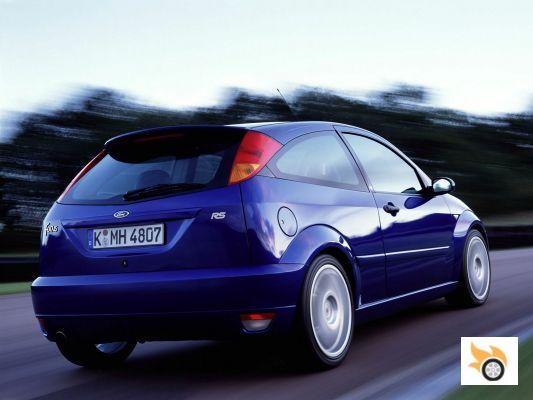
It was a car that was very sensitive to the geometry of the rear suspension, so you had to have it well aligned.
Interestingly, something strange happened at Ford before the launch of this car. Two final set-ups arrived at the cut-off, a few days before the car was presented to the press. One had more toe and camber on the rear wheels than the other. Part of the engineers wanted to present the more racing option, as the cars were more entertaining and agile, more responsive from the rear axle. Another part doubted the difficulty of the car. And the fact is that these cars, in the wet and without stability control, can be a bit tricky.
So, the impressions of many of those who tested the car in the first instance varied, as the press units were not all configured under the same pattern. I personally had to deal with two different units in the workshop. When put in the aligner we discovered half a degree difference in toe-in between the two. Obviously, for dry tarmac and fun, the lower toe in the rear is something interesting, especially because the car handles it well. The problem is that without ESP to help you and a self-locking differential, in very wet conditions, the car can be a bit tricky when you're looking for a tickle. So did Ford get it right with the softer set-up? I don't know. The good thing is that it's something the end user can play with the help of a specialist alignment centre and the right geometry data from the manufacturer to find that perfect balance between agility and personal safety. It's just like in the "pata negra" rally cars.
Officially, the "correct" decimal degree rear end setting is 0.35° of toe-in with a tolerance of 0.15°, although Ford would allow any measurement between 0.60° and 0.10°. Playing with the right 0.10° of toe-in on the rear end will allow you to get closer to that playful car. Many end customer units were at 0.60°, and even, as I say, the one we saw in the workshop was at 0.75°.
Rear wheel camber in decimal degrees must be nominally negative 1.44°, although here again the margin is very large, with Ford giving Fords from -0.12° to -2.76°. With more than two and a half degrees of negative camber we will have a more playful car, but if we combine that with the minimum toe-in, we can end up with worn wheels on the inner sidewall in a few kilometres.
What to check, what to modify, how much to pay?
The truth is that the Focus RS has a "bad reputation" in terms of reliability, but the reality is that it is a very tough, reliable and resistant car, with a block that, thanks to being made of steel and having forged pistons and connecting rods, rarely gives problems if you take good care of it (fluids and lubricants) and use the gasoline indicated by the manufacturer, with 98 octane.
However, like any performance car, it has its weaknesses that deserve a review before proceeding with the purchase. It is also worth remembering that, as always with this profile of car, the most important thing is to find an owner who has been careful with the car, being that in fact more relevant than the kilometers it has in total.
- Intake air cooling system: As explained above, this car has an air-liquid exchanger system to cool the intake air, once compressed by the turbo.
The problem is that over the years, the pump of this cooling system tends to break down, or even the circuit to clog. To check the perfect functioning of the system, you have to open the filler cap of this liquid with the engine running and see that there is a flow of liquid at idle (calm, this liquid is not very hot).
- Rust: Due to the adjustment of some plastic parts, small rust bubbles may appear in the area of the rear number plate (on the upper handle), and also under the side mirrors. The bodywork is zinc plated, so the corrosion will not go any further, but it is worth checking this in case a repair is needed.
Likewise, the front wings (special to the RS) can also rust on their inner edge facing the wheel.
- Suspension ball joints: As in almost all high performance cars with rigid suspensions, suspension bushings and ball joints suffer. Check that the car has a precise driving and that the steering wheel does not vibrate, if not you will have to change them, something that without being exaggeratedly expensive, has its work.
- Leaks in the cooling circuit: The cooling circuit may leak in the area of the thermostat (which can burst). Any fluid leak you see in the engine is suspicious, and some can cause rust in the engine bay.
- Oil leaks: The junction of the lubrication hoses with the turbocharger usually causes oil leakage problems. Check that this is not the case.
- Check the condition of the turbocharger: Although all the other problems and defects are minor, checking that the car does not blow blue smoke from the exhaust is vital, as in any turbo engine, to check that the turbine seals are in perfect condition. If not you will have a thousand euro repair ahead of you.
- Various niggles: There are several typical details of the first generation Focus that are also a problem in the RS, such as the rear windscreen wiper, which stops working, or the engine bonnet anchor, which sometimes makes the bonnet shake. Check it out.
- Lack of spare parts: One of the big downsides of the Focus RS is that with less than 5,000 units sold, and all of them driven "under the knife", plus a lot of tuners wanting to convert their normal Focus into an RS, there are certain spare parts such as wings or bumpers that are not at all easy or cheap to get, although Ford decided to remanufacture parts that are available again, so don't despair.
The valuation for a unit in decent condition can be around 10.000€. In an ideal world, finding a unit with a stamped service book and a single, or two, very careful owners would be perfect. Looking at the make and condition of the tyres fitted is usually a good way of finding out how careful the previous owner was...
As for preparations, the truth is that it is a car that I would hardly touch. The standard suspension is very good, and I think it's unnecessary to upgrade to a Bilstein or similar. The same goes for the brakes. The most you can do is to play with reprogramming, an exhaust manifold with independent outputs and a less restrictive catalytic converter, if you want to gain "some "some juice". But I wouldn't touch much more... Of course, some Pilot Sport of the new ones will also give you extra grip.
Conclusions
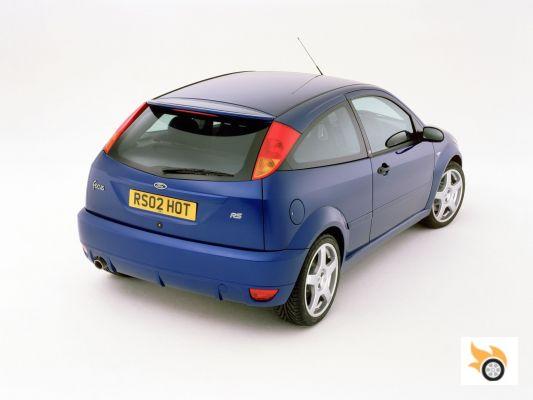
Without electronic driving aids, but with a self-blocking at the front, it's a car to get excited and have fun in every mountain pass curve.
With only 4,501 units produced, the Focus RS is exclusive. It was only produced in blue, by the way. From that exclusivity comes the first desirability factor of this car, as it is rarer to see than other equivalent models.
Dynamically it was the most radical of its fifth, by sound and response. Aesthetically it's a car that when you see it live you can see it through the eyes without using radical resources, thanks to its extra wide track, its rims and its bumper.
Personally I will tell you that it is one of my favorites, with its self-locking, its way of moving and the response of its "old school" engine. The downsides? It's a car that requires good hands to drive it fast, being pre-electronic-generation. It's not one of those "foolproof" ones that are flooding the market now, but that, for me, at the same time is an advantage.
Would I buy it over USPI's 147 GTA last week? That's a great question. The Alfa is more GT, more comfortable for long journeys, but it's more expensive and not as lively in corners, even if it sounds better and has a fuller engine from lower down... I'd go for the Focus, because of the "I'm more racing than classy" thing, but I'd be very happy with either one.

























